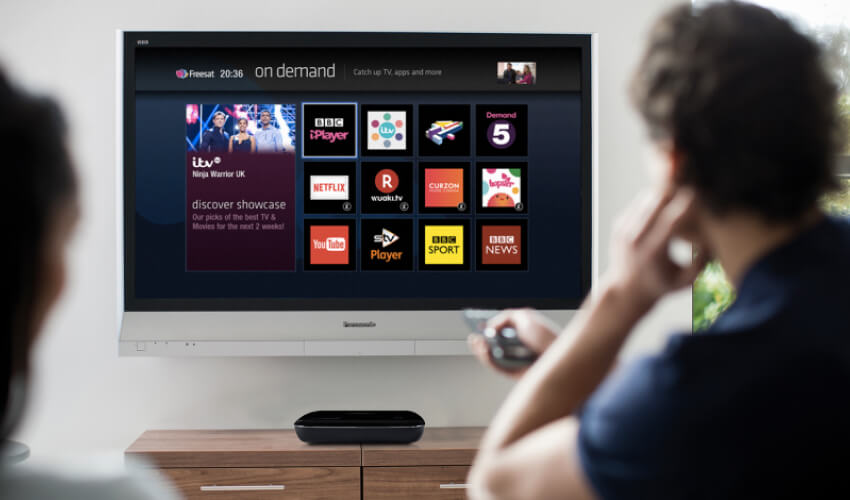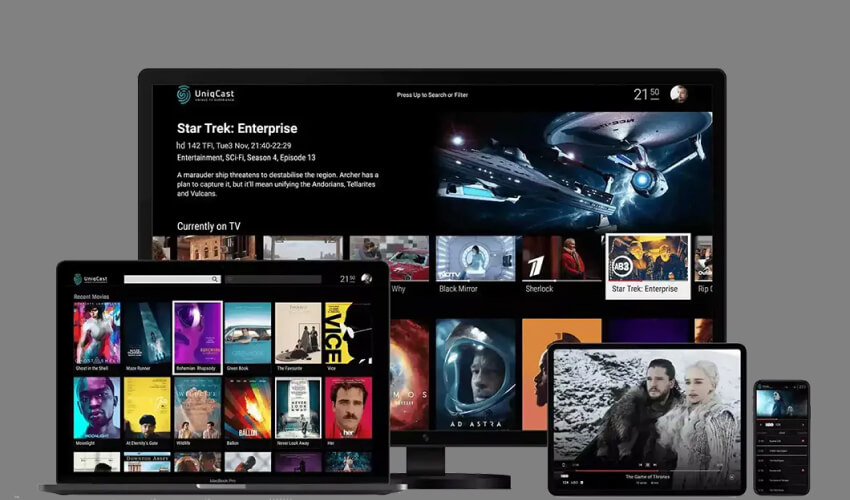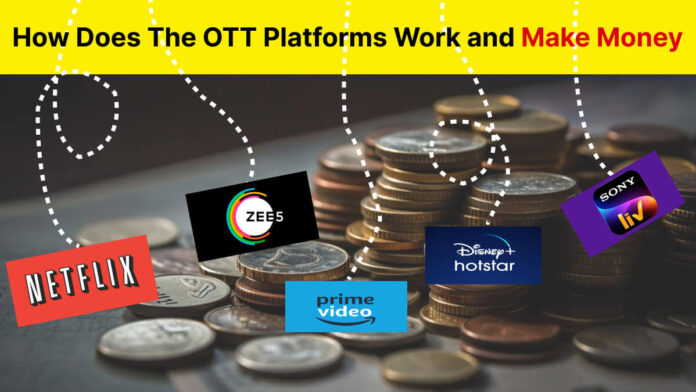Over-the-top (OTT) platforms have gained immense popularity in the past few years, especially after the COVID-19 pandemic. There are over 40 OTT Platforms Work and Make Money worldwide, with a total revenue of $202.5 billion in 2022. According to studies, the revenue of OTT platforms is expected to rise by more than double by 2027.
But the question is how OTT platforms earn money.
Yes, most of you must be wondering how these Over-the-top platforms make money. So, if you’re also pondering the same, read this post.
In this blog post, we will go through the various ways that over-the-top (OTT) platforms generate revenue.
Table of Contents
- What exactly is an OTT Company?
- How have OTT platforms changed the viewers’ experience?
- How OTT Platforms Earn Money?
Before we see how OTT platforms earn money, let’s first understand what OTT company is and how these companies are capitalizing on the increasing preference for online streaming among viewers. Here we go…
What exactly is an OTT Company?
Over-the-Top, popularly known as the OTT platform, refers to content providers who offer their users media content that is streamed directly to them over the Internet rather than through traditional cable or satellite TV services. Streaming, also known as “live streaming,” is used to transmit or receive digital content in real time over the Internet. It enables the real-time transfer of various types of data, including movies, series, etc., over the Internet.
The over-the-top company allows people to watch material on-demand over a smartphone, smart TV, iPad, laptop, and tablet, among other devices. There are many OTT platforms, including Amazon Prime, Netflix, Disney HotStar, Zee5, Eros, JioCinema, Hulu, and so on. Most platforms let users have access for free, while others charge recurring subscription fees.
Overall, OTT platforms have had a significant impact on users’ video-watching experience, leading to a highly demanding industry today.
How have OTT platforms changed the viewers’ experience?
OTT platforms have become very popular in the past few years, especially post-COVID-19 pandemic. The introduction of over-the-top (OTT) streaming has given consumers a new way to consume content online. The global Over the Top Market was valued at around $202.5 billion in 2022. The OTT market revenue is expected to reach approximately $434.5 billion by the end of 2027, with a projected compound annual growth rate (CAGR) of 16.5% during the period of 2022-2027.

Source: Inc42
The major reason for the OTT platform’s popularity is the ability of users to watch videos on any device. People can watch their favourite content on the go. Whether you’re traveling to an international location or are commuting from office to home by metro, you can enjoy watching videos on your phone or any other device of your choice.
Observing this shift in viewership has piqued the interest of content producers and owners worldwide. That’s the reason more and more companies are coming forward with their own platform.
How has online streaming among viewers impacted the growth and success of existing over-the-top (OTT) businesses?
Undoubtedly, OTT platforms have made watching movies, series, and other type of content a breeze for all. People from all walks of life have shifted from traditional TV-watching to online streaming. According to research, over 424 million people prefer watching content on OTT platforms. By 2027, the OTT video market is predicted to have 4.22 bn users.
This presents content creators and owners with a fresh opportunity to reach out to a new audience base. Additionally, live video streaming has emerged as one of the most well-liked approaches to watching videos, making companies implement live streaming technologies in their marketing strategies in order to present their customers with fresh content and strengthen their relationships with them.
With the increasing preference for online streaming, over-the-top companies have a great opportunity to provide top-notch content and generate revenue.
Also See : How Do Free Apps Make Money: Top 8 Proven Strategies
How OTT Platforms Earn Money?
When it comes to how OTT platforms make money, there are majorly 6 models that they use, which are as follows:
- Subscription Video on Demand (SVOD)
- Transactional Video on Demand (TVOD)
- Advertising-based Video on Demand (AVOD)
- Hybrid Model
- Multi-Screen Model
- TV Everywhere (TV-E)
Here is a detailed description of each model to help you understand how OTT platforms earn money. Take a look…
1. Subscription Video on Demand (SVOD)
SVOD, or Subscription Video on Demand, is a pretty popular model that most over-the-top companies use. This model very much resembles the traditional TV packages. In this model, users need to subscribe to a particular OTT platform. It offers users the freedom to enjoy a wide range of content at their own pace, all for a fixed monthly or quarterly fee.

Source: godxia.top
Some of the most popular streaming services, including Netflix, Amazon Prime Video, and Hulu, use the SVOD model.
With SVOD service, you have the freedom to opt-out at any time. Platforms using the SVOD model provide you with enhanced flexibility. The subscription video-on-demand business model enables OTT companies to generate enormous profits. Consumers have access to a vast library of video content that they can enjoy watching at any time and from any location.
In recent years, there has been a substantial rise in the demand for subscription video on demand. It is because an increasing number of users are inclined toward online streaming. More and more people have now disconnected their cable connections. With OTT Platforms, users are now able to access streaming services using any device, including handheld, more easily. All they need is a good internet connection so that they can enjoy uninterrupted video streaming online.
One of the most significant advantages of SVOD is that it helps OTT companies generate recurring revenue. Instead of depending on one-time sales or revenue from advertising, SVOD delivers a consistent stream of income from customers who pay on a regular basis.
2. Transactional Video on Demand (TVOD)
TVOD, also known as transactional video on demand or pay-per-view, is yet another business model OTT platforms earn money. Unlike SVOD, TVOD users have the option to buy content on a pay-per-view basis. This model is further divided into two sub-categories, namely electronic sell-through (EST), and download-to-rent (DTR).
The electronic sell-through, or EST, allows permanent access to a piece of content by making a one-time payment. Whereas, in download to rent, or DTR, customers can access a piece of content for a limited time by paying a smaller fee.
TVOD services are pretty popular among people who do not want to subscribe to OTT platforms. These services allow users to have access to the content they wish to watch. These services generate higher revenues for rights holders while ensuring that consumers can enjoy the most recent releases.
Some of the most popular platforms using TVOD services include Amazon Prime, iTunes Store, YouTube, and Apple TV. These platforms offer the flexibility of both subscription and pay-per-view models for your hosted video.
TVOD services offer customers the ability to just pay for the material that they wish to see. This is the reason an increasing number of individuals are selecting TVOD as their preferred model. Undoubtedly, SVOD offers a wider selection of content. However, there are people who prefer to watch selective content, such as Hollywood movies, new releases, or sporting events, which makes TVOD a preferred service for many.
The best thing about the TVOD model is that users pay a one-time fee for each piece of rented or purchased content. TVOD is one of the best services for people who do not like to commit to a subscription model. So, it is a kind of win-win situation for both users and OTT platforms. Users can pay for content they wish to watch without having to subscribe to the whole platform, and companies can generate instant revenue by providing premium content to users.
3. Advertising-based Video on Demand (AVOD)
Advertising-based Video on Demand, commonly known as AVOD, is a pretty popular model among OTT platforms. Many OTT Platforms make money using this model. Unlike SVOD and TVOD services, AVOD is completely free for consumers. However, just like traditional broadcast television, viewers need to endure advertisements.

Source: Morioh
The most popular platform that uses Advertising-based Video on Demand is YouTube. You must have seen that you don’t need to pay any money to watch a video; however, there are ads in between the content. Platforms that use the AVOD model earn money through ads. They utilize ad revenue to cover the expenses of production and hosting.
Undoubtedly, the AVOD model is perfect for users as they don’t require to pay anything. However, it tends to generate lower revenue compared to SVOD and TVOD models. Popular video-on-demand (VOD) services like YouTube, Roku Channel, and VUDU use the AVOD model to earn money. They provide users with access to a wide range of user-generated and professionally produced ad-supported content for free.
Customers get access to a wide variety of content without having to pay for it when using the AVOD model. At the same time, OTT platforms earn money through the use of advertisements. Streaming platforms generate revenue by selling advertising space rather than charging users to access the content. It helps both OTT platforms and businesses. OTT platforms generate revenue using this model, while businesses use these OTT platforms to reach their target audience.
There are three stages at which the content’s advertisements are displayed, including the pre-roll, mid-roll, and post-roll. This means that some content will have advertisements at the beginning, some will have advertisements in the middle, and some will have advertisements at the end. There are skippable and non-skippable variations of some video advertising.
AVOD revenue model is considered best for content creators who are just starting out and have a limited budget. For example, homemakers start a cookery channel on YouTube. It helps people to make money in the comfort of their place. Also, it helps users to view a wide variety of content on similar topics at no cost. That’s the reason the AVOD revenue model is expanding at a faster rate than ever before.
4. Hybrid Model
The hybrid over-the-top (OTT) business model, as the name says, is the combination of more than one or more models. This model has gained immense popularity in the last few years. It is because this model enables OTT platforms to reach a larger audience and monetize their content in numerous ways. It helps decrease the number of subscribers that cancel their subscriptions and increases the customer’s lifetime value.
The best thing about the hybrid model is that it can be customized to increase income. That’s the reason it has become increasingly popular among OTT brands. Disney+ and a number of sports streaming companies use a hybrid model.
There are a few distinct approaches to hybridization, including the combination of AVOD and SVOD. In this type of hybridization, platforms make both paid and free content available to their users, such as JioCinema. More often than not, the free content is interspersed with advertisements to users. In contrast, the paid one is free of advertisements. Numerous platforms are currently adapting new hybrid models in order to better serve customers. YouTube, Vimeo, Disney+, Discovery, and other platforms use AVOD and SVOD models.
Another hybridization that some OTT platforms opt for includes a transactional video-on-demand (TVOD) model and a subscription-based model. This model makes ad-supported content available to viewers without charge, while a paywall protects premium content that can only be rented or purchased.
Pay-per-view options are available for newly released content or live events; however, all subscribers have access to the service’s back history of recordings. Customers can watch ad-supported content and pay a membership fee in between to watch the content with fewer ads. Or they have the ability to buy a complete membership to watch content without ads. Companies using this model provide a combination of free and paid content to users. Using this model, OTT platforms can attract a huge audience while also making money. All in all, the hybrid over-the-top (OTT) revenue model is pretty beneficial for OTT companies and direct advertisers as it enables them to reach a larger audience.
5. Multi-Screen Model
Then there is multi-screen model. In this model, users subscribe to watch content on different devices. If you subscribe to multi-screen model, you can have others in your family watching their favourite content when they want. All you have to do is to share your login details with others.

With more and more people leaving broadcast and paid TV in favour of over-the-top (OTT) streaming alternatives, pay-TV providers are implementing a strategy known as TV Everywhere. In this model, users can access content from any device, including Smart TVs, Smart Phones, and so on.
In recent years, there has been a substantial expansion in the market for multi-screen OTT services. One of the primary factors that has contributed to the expansion of multi-screen OTT services is the ease of use and adaptability. A growing number of consumers are now enjoying video content on various screens. It presents exciting prospects for pay-TV providers and satellite providers to adopt innovative multiscreen business models.
TV Everywhere and multiscreen services are revolutionizing the cable and satellite industry. It enables providers to enhance customer loyalty and minimise churn. Multi-screen model is a valuable tool for Pay-TV providers. It helps companies strengthen customer loyalty and drive additional revenue by encouraging customers to upgrade from lower-value packages to more comprehensive multi-play bundles.
It also helps pay-TV providers to create their own OTT-like video services and expand their reach to non-customers and generate extra revenue. You only need high-speed Internet and a user subscription to enjoy these bundles. It will allow you to switch between devices without interrupting your viewing experience.
The increasing popularity of mobile devices combined with advancements in 5G technology has accelerated the spread of the multi-screen OTT business model. Users can stream high-quality video content on several screens and devices simultaneously. Multi-screen OTT is expected to grow as more people use streaming services for entertainment. This model allows users to access their preferred content on any platform and at any time. The best thing about this model is that users can start watching again exactly where they left off watching.
6. TV Everywhere (TV-E)
TV Everywhere, popularly known as TV-E, is yet another OTT business model. With more and more people switching to online streaming, Pay-TV providers have developed a strategy called TV Everywhere.

Source: PopOptiq
TV-E allows traditional broadcasters to cross-platform their services, which is necessary in light of the growing migration to OTT platforms. Users can opt for packages to view their preferred television channels on an over-the-top (OTT) platform. This eliminates the need to subscribe to cable television.
The best thing about this model is that users are able to view their preferred television channels on various devices and from any location. Of course, TV-E is still in its infant stages. However, it has gained immense traction. In this model, OTT firms are allowed to provide content from third parties without producing it themselves. Both on-demand video-on-demand (AVOD), in which revenues are split between the OTT provider and the TV channel, and subscription video-on-demand (SVOD), in which the content of the channel is included as part of the subscription, are compatible with this business model.
Wrapping it up…
So, now we wrap up our article titled “How OTT platforms make money.” We are sure it will help you have enough understanding on how OTT platforms earn money. OTT platforms have gained immense traction, and for all good reasons.
Primarily, the increase in the availability of high-speed Internet, a proliferation of connected devices, and a growing number of content creators producing high-quality original content have given rise to the acceleration of OTT Platforms.
These platforms provide users with a wide variety of content to stay entertained at any time. There was a time when people had to go to theatres to watch movies. Today, they have access to a wide range of online content at any time. Now you don’t need to go out of your home to watch your favourite movie. Even the movies that are released in theatres are made available to people for online streaming. In addition, OTT platforms eliminate the need to book tickets or move out in scorching heat or extremely cold weather. Users can enjoy their favourite content without having to go through any hassle.
One of the best things about OTT services is that they cater to viewers of all ages. They have everything from Hollywood blockbusters to regional language TV shows. The content on these sites is constantly updated to ensure your continued enjoyment at your convenience.
However, when it comes to choosing the right OTT business model, companies need to be careful. Each over-the-top (OTT) revenue model offers its own advantages and disadvantages. It is essential for over-the-top service providers to identify a revenue model that is compatible with both their intended customer base and their overall business objectives.
The amount of money brought in by over-the-top (OTT) services has been expanding at a rapid rate. And it is anticipated that the revenue generated by these platforms will continue to grow in the future. Hence, it is essential that OTT service providers choose their business model wisely.
Enjoy watching your favourite content on OTT Platforms 😊 😊


